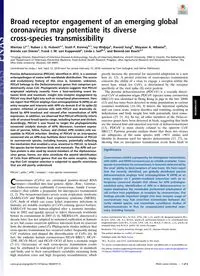
2018 Broad receptor engagement of an emerging global coronavirus may potentiate its diverse cross-species transmissibili PDF
Preview 2018 Broad receptor engagement of an emerging global coronavirus may potentiate its diverse cross-species transmissibili
Broad receptor engagement of an emerging global coronavirus may potentiate its diverse cross-species transmissibility Wentao Lia,1, Ruben J. G. Hulswita,1, Scott P. Kenneyb,1, Ivy Widjajaa, Kwonil Jungb, Moyasar A. Alhamob, Brenda van Dierena, Frank J. M. van Kuppevelda, Linda J. Saifb,2, and Berend-Jan Boscha,2 aVirology Division, Department of Infectious Diseases & Immunology, Faculty of Veterinary Medicine, Utrecht University, 3584 CL Utrecht, The Netherlands; and bDepartment of Veterinary Preventive Medicine, Food Animal Health Research Program, Ohio Agricultural Research and Development Center, The Ohio State University, Wooster, OH 44691 Contributed by Linda J. Saif, April 12, 2018 (sent for review February 15, 2018; reviewed by Tom Gallagher and Stefan Pöhlmann) Porcine deltacoronavirus (PDCoV), identified in 2012, is a common enteropathogen of swine with worldwide distribution. The source and evolutionary history of this virus is, however, unknown. PDCoV belongs to the Deltacoronavirus genus that comprises pre- dominantly avian CoV. Phylogenetic analysis suggests that PDCoV originated relatively recently from a host-switching event be- tween birds and mammals. Insight into receptor engagement by PDCoV may shed light into such an exceptional phenomenon. Here we report that PDCoV employs host aminopeptidase N (APN) as an entry receptor and interacts with APN via domain B of its spike (S) protein. Infection of porcine cells with PDCoV was drastically re- duced by APN knockout and rescued after reconstitution of APN expression. In addition, we observed that PDCoV efficiently infects cells of unusual broad species range, including human and chicken. Accordingly, PDCoV S was found to target the phylogenetically conserved catalytic domain of APN. Moreover, transient expres- sion of porcine, feline, human, and chicken APN renders cells sus- ceptible to PDCoV infection. Binding of PDCoV to an interspecies conserved site on APN may facilitate direct transmission of PDCoV to nonreservoir species, including humans, potentially reflecting the mechanism that enabled a virus, ancestral to PDCoV, to breach the species barrier between birds and mammals. The APN cell sur- face protein is also used by several members of the Alphacorona- virus genus. Hence, our data constitute the second identification of CoVs from different genera that use the same receptor, imply- ing that CoV receptor selection is subjected to specific restrictions that are still poorly understood. PDCoV | spike | APN | receptor | cross-species transmission C oronaviruses (CoVs) are enveloped positive-strand RNA viruses—classified into four genera: Alpha-, Beta-, Gamma-, and Deltacoronavirus (subfamily Coronavirinae, family Corona- viridae)—that exhibit a propensity for interspecies transmission (1, 2). The betacoronaviruses severe acute respiratory syndrome (SARS)-CoV and Middle East respiratory syndrome (MERS)- CoV, both of which can cause lethal respiratory infections in humans, are notable examples of CoVs crossing species barriers. SARS-CoV became human-adapted after a zoonotic introduc- tion in 2002 and quickly spread to infect thousands worldwide before its containment in 2003 (3, 4). MERS-CoV, discovered a decade later, has not adapted to sustained replication in humans as yet, but causes recurrent spillover infections from its reservoir host, the dromedary camel (5). Phylogenetic studies indicate that cross-species transmission has occurred rather frequently during CoV evolution and shaped the diversification of CoVs (6). In fact, the endemic human coronaviruses HCoV-HKU1, HCoV- 229E, HCoV-NL63, and HCoV-OC43 all have a zoonotic origin (7–11). Occurrence of such cross-species transmission events may be attributed to widespread CoV prevalence in mammals and birds, and to their extraordinary variability stemming from high mutation rates and high frequency recombination, which greatly increase the potential for successful adaptation to a new host (6, 12). A pivotal criterion of cross-species transmission concerns the ability of a virus to engage a receptor within the novel host, which for CoVs, is determined by the receptor specificity of the viral spike (S) entry protein. The porcine deltacoronavirus (PDCoV) is a recently discov- ered CoV of unknown origin. PDCoV (species name coronavirus HKU15) was identified in Hong Kong in pigs in the late 2000s (13) and has since been detected in swine populations in various countries worldwide (14–24). It infects the intestinal epithelia and can cause acute, watery diarrhea and vomiting, resulting in dehydration and body weight loss with potentially fatal conse- quences (23, 25, 26). So far, all other members of the Deltacor- onavirus genus have been detected in birds, suggesting that birds are the natural host and ancestral reservoir of deltacoronaviruses (13). PDCoV is most closely related to the sparrow CoV HKU17. Pairwise genome analysis shows that these two viruses are subspecies of the same species with >96% amino acid identity in domains used for species demarcation (13, 27), in- dicating that an interspecies transmission event from birds to Significance Coronaviruses exhibit a propensity for interspecies transmission, with SARS- and MERS-coronaviruses as notable examples. Cross- species transmission by coronaviruses is foremost determined by the virus’ ability to bind receptors of new hosts. We here report that the recently identified, yet globally distributed porcine deltacoronavirus employs host aminopeptidase N (APN) as an entry receptor via S protein-mediated interaction with an in- terspecies conserved domain that allows for APN orthologue- mediated entry. Identification of APN as a deltacoronavirus re- ceptor emphasizes the remarkable preferential employment of cell surface host peptidases as receptors by coronaviruses. Our findings provide important insight into how receptor usage of coronaviruses may fuel cross-host transmission between dis- tantly related species and necessitate surveillance studies of deltacoronaviruses in thus far unappreciated potential reser- voirs, including humans. Author contributions: W.L., R.J.G.H., S.P.K., I.W., L.J.S., and B.-J.B. designed research; W.L., R.J.G.H., S.P.K., I.W., K.J., M.A.A., and B.v.D. performed research; L.J.S. contributed new reagents/analytic tools; W.L., R.J.G.H., S.P.K., I.W., K.J., M.A.A., F.J.M.v.K., L.J.S., and B.-J.B. analyzed data; and R.J.G.H. and B.-J.B. wrote the paper. Reviewers: T.G., Loyola University Chicago; and S.P., German Primate Center. The authors declare no conflict of interest. Published under the PNAS license. 1W.L., R.J.G.H., and S.P.K. contributed equally to this work. 2To whom correspondence may be addressed. Email:
